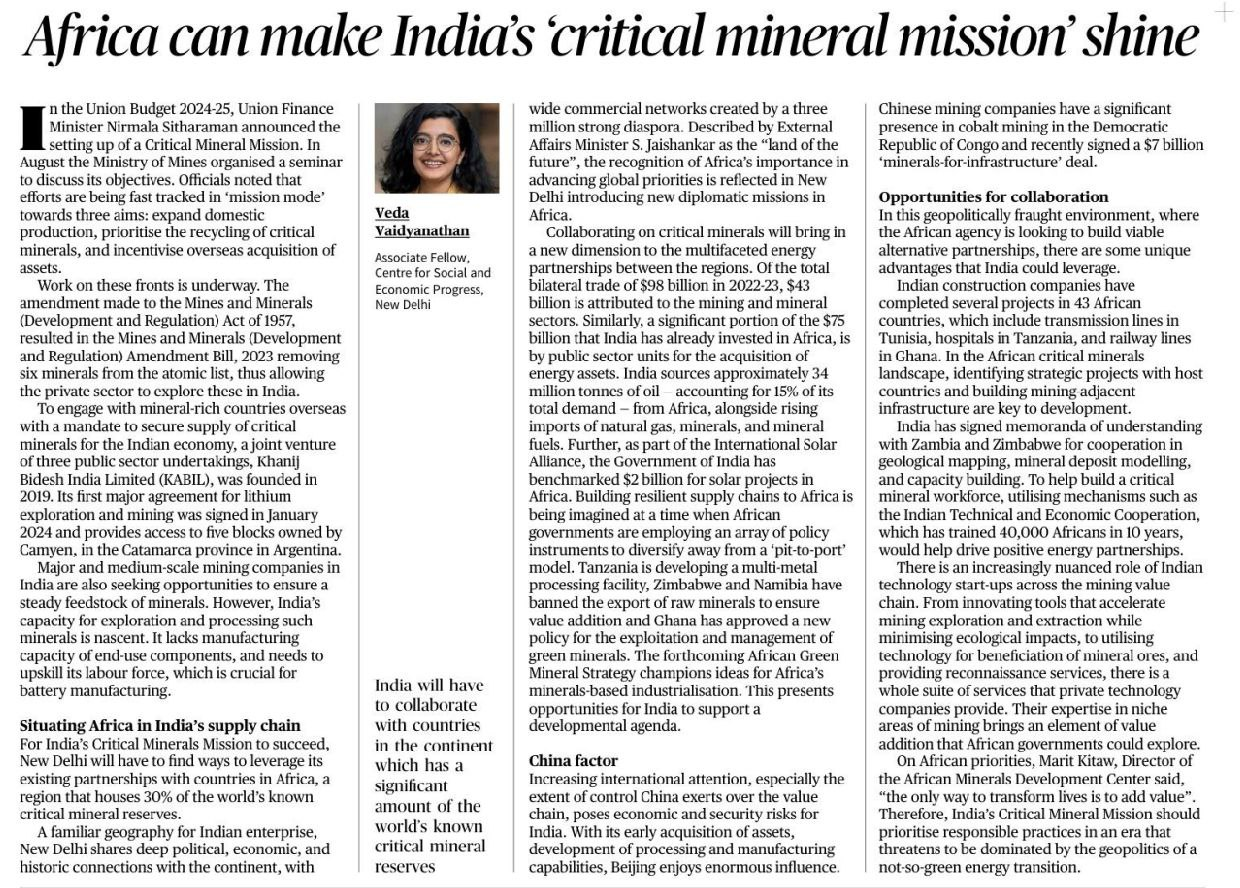1. Critical Mineral Mission – Role of Africa and World
Introduction:
- In the Union Budget 2024-25, the Indian government launched the Critical Mineral Mission to ensure the supply of critical minerals necessary for India’s energy transition and industrial growth.
- Africa is crucial to this mission due to its vast reserves of critical minerals and its growing economic and strategic ties with India.
Importance of Critical Minerals:
- Critical minerals like lithium, cobalt, and rare earth elements are essential for renewable energy, electric vehicles, and advanced technologies.
- The Mines and Minerals Development and Regulation (MMDR) Amendment Bill, 2023 was passed to encourage private sector participation in critical mineral exploration in India.
India’s Efforts in Critical Mineral Sourcing:
- Khanij Bidesh India Limited (KABIL) was formed in 2019, focusing on securing critical minerals overseas.
- First agreement signed in January 2024 for lithium exploration in Argentina.
- India’s mining industry, though expanding, lacks processing capacity for critical minerals, highlighting the need for infrastructure and skill upgradation.
Why Africa is Important:
- Africa holds around 30% of the world’s known critical mineral reserves.
- Collaborating with Africa can help India secure a resilient supply chain of critical minerals.
- Example: India’s investment in Africa’s mining and energy sectors accounted for $43 billion out of $98 billion in bilateral trade (2022-23).
- African nations like Zambia, Zimbabwe, and Ghana are implementing policies to manage mineral extraction sustainably.
Opportunities for Collaboration:
- Indian construction companies are already involved in several African projects (transmission lines in Tunisia, railways in Ghana).
- Collaboration could expand to mining infrastructure, energy, and mineral processing industries.
- African countries are seeking to build alternative partnerships to reduce dependence on traditional powers like China.
- India’s International Solar Alliance has benchmarked $2 billion for solar projects in Africa, offering further avenues for cooperation.
Challenges and the China Factor:
- China has a significant presence in Africa, especially in cobalt mining in the Democratic Republic of Congo.
- China’s early investments and technological capabilities pose a challenge for India’s efforts in Africa’s critical mineral sector.
Conclusion:
India’s Critical Mineral Mission can be significantly bolstered by partnerships with African nations. The mission offers mutual benefits: securing supply chains for India while contributing to Africa’s development goals. India must focus on building resilient supply chains, investing in mining infrastructure, and creating policies that benefit both regions in a globally competitive mineral market.
Mains Practice Question: |
Q. “Discuss the strategic importance of Africa in securing India’s critical mineral needs and the challenges posed by China’s influence in the region. How can India leverage its diplomatic and economic ties with African nations to secure its energy transition?” |
2. National Food Security Act (NFSA) 2013
Introduction:
The National Food Security Act (NFSA) 2013 was introduced to address food security by providing subsidized food grains through the Public Distribution System (PDS). However, there were concerns about its effectiveness due to high PDS leakages. Despite this, states that had undertaken PDS reforms demonstrated significant improvements in reducing these inefficiencies, providing a hopeful outlook for nationwide reforms.
Challenges Faced by PDS Pre-NFSA (2011-12):
- High Leakages: In 2011-12, all-India leakages in PDS were 41.7%, according to National Sample Survey (NSS) data.
- Specific states faced massive leakages: Bihar (91%), Chhattisgarh (52%), Odisha (76%).
PDS Reforms Pre-NFSA:
- Early Reforming States: Between 2004-05 and 2011-12, states like Bihar, Chhattisgarh, and Odisha reduced PDS leakages dramatically (Bihar from 91% to 24%, Chhattisgarh from 52% to 9%, Odisha from 76% to 25%).
- Reforms:
- Reduction in PDS prices.
- Doorstep delivery of food grains.
- Digitisation of records.
- De-privatisation of PDS management (managed by panchayats and self-help groups).
NFSA 2013 and Its Impact:
- Mandated PDS Reforms: NFSA incorporated the same package of reforms that were successful in early reforming states.
- Improved Coverage: The proportion of households accessing the PDS increased from 40% in 2011-12 to 70% in 2022-23.
- Reduction in Leakages: The HCES 2022-23 suggests that PDS leakages reduced to 22% nationally.
- Rajasthan (9%), Jharkhand (21%), and Uttar Pradesh (23%) saw improvements, which were once high-leakage states.
Limitations and Challenges of NFSA:
- Shortfall in Coverage: Despite improvements, only 59% of the population accessed PDS as NFSA beneficiaries, lower than the mandated 66%.
- Non-NFSA Beneficiaries: Approximately 10% of the households accessing the PDS were non-NFSA beneficiaries.
- Aadhaar’s Limited Impact: Contrary to popular belief, Aadhaar-based biometric authentication (ABBA) did not significantly impact reducing leakages. States like Jharkhand already had low leakages before its introduction.
Disparities in PDS Performance:
- Successful States: Rajasthan, Jharkhand, and UP showed significant improvement in PDS efficiency.
- Worsening States: Some states like Tamil Nadu saw an increase in leakages, from 12% in 2011-12 to 25% in 2022-23.
Current State and Future Reforms:
- Strengthening the PDS: The PDS has become an effective tool for food security, crucial during the COVID-19 pandemic. However, there are ongoing challenges, such as:
- Innovations like cash transfers and Aadhaar-based authentication that might complicate PDS functionality.
- Delayed Census results leading to the exclusion of around 100 million people.
- Demands for Improvement:
- Inclusion of more nutritious items like pulses and edible oil.
- Avoiding misaligned technological interventions such as the ongoing eKYC drive.
Conclusion:
The NFSA 2013 has brought notable improvements to the PDS, with significant reductions in leakages and increased coverage, particularly in states that implemented reforms. However, challenges remain, including incomplete coverage, technological hurdles, and the need for better nutritional options. The government must focus on building a more inclusive and efficient PDS, rather than relying on technological solutions that may exclude beneficiaries.
Mains Practice Question: |
“Critically examine the impact of the National Food Security Act (NFSA) 2013 on the Public Distribution System (PDS) in India. Discuss the challenges in ensuring food security and suggest measures for improving PDS efficiency.”
|



